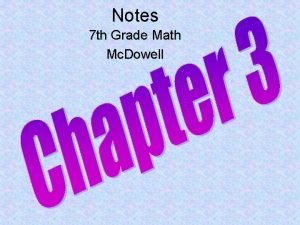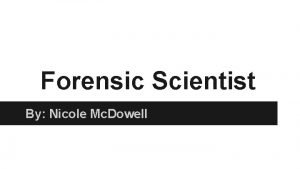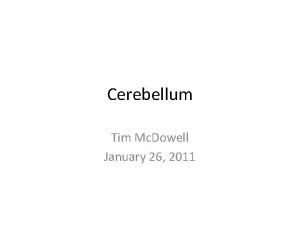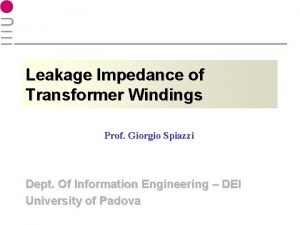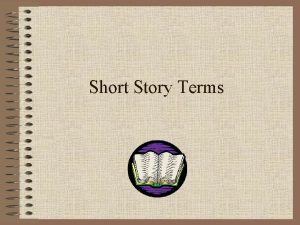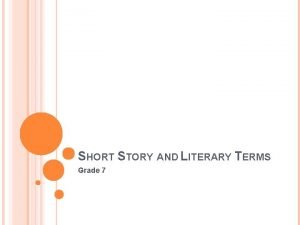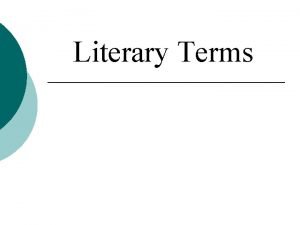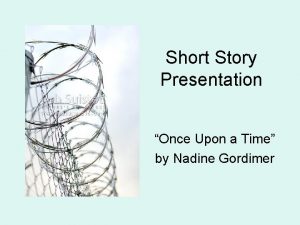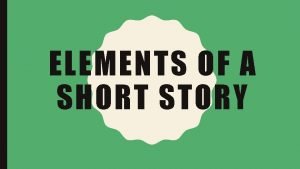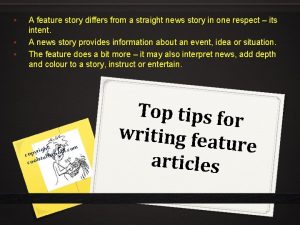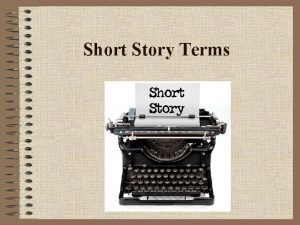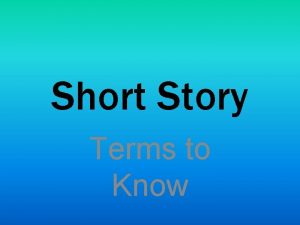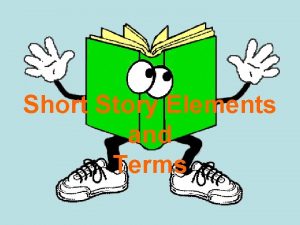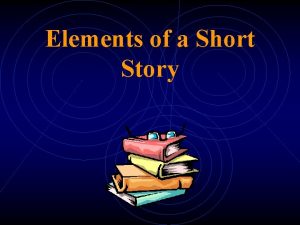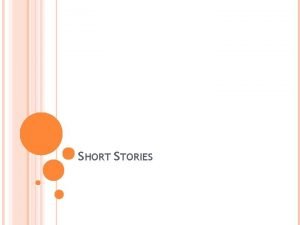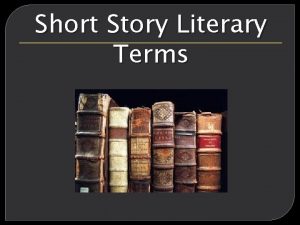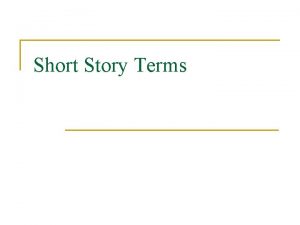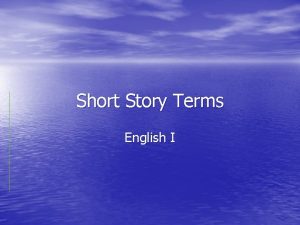SHORT STORY TERMS 11 Ms Mc Dowell Short

















- Slides: 17

SHORT STORY TERMS 11 Ms. Mc. Dowell

Short Story: A fictional tale of a length that is too short to publish in a single volume like a novel. Short stories are usually between five and sixty pages; as a result, they can be read in a single sitting. Usually, short stories concentrate on a single event with only one or two characters. The short story has three main elements: plot, characterization, and setting. In addition, short stories also contain other devices/features including: theme, conflict, point of view, suspense, foreshadowing, and flashback.

A. Plot: The events of the story or the series of actions that make up the story are referred to as the plot. Basically, the plot is what happens in the story. Traditionally, it is divided into five parts. Introduction: The reader meets the characters and discovers the setting. Reader interest is stirred here. The conflict that drives the story’s action is discovered at the end of the introduction, with the inciting incident.

Rising Action: Builds up the story (the longest part)— a series of steps that lead to the climax. You get more information about conflict and character here. Climax: Here, the reader finds out what happens to the conflict, or how the conflict might be resolved. The story may not yet be finished, but the reader now has a good understanding of what way it is going to go. Typically this is the turning point of the story.

Falling Action: The plot begins to wrap up in this section of the story, which is usually brief. Conclusion/Resolution/Denouement: This part follows quickly after the climax and provides the last pieces of information for the reader. “Denouement” is French for “unknotting”; you may therefore think of denouement as “untangling” of the plot. 5. A. There are four types of conclusions and they have a variety of names: Expository Happy: All loose ends are tied up and explained and the ending is happy. Expository Sad: All loose ends are tied up and explained and the ending is sad. Surprise or Twist: Something happens that the reader does not expect at all. Unresolved/Indeterminate/Cliffhanger: The reader is left with questions and has to, in part, supply the ending him or herself. Some loose ends are left to dangle.

5. B. Anti-Climax: A dull or disappointing ending to something after increasing excitement. For example: After the weeks of preparation, the concert itself was a bit of an anticlimax. In connection to a story or novel, it means an ending that doesn’t measure up to the plot events that precede it (the ending is anticlimactic).

Plot Diagram: Also known as Freytag’s Pyramid, the story diagram or plot diagram, was invented in 1864 by Gustav Freytag to visually represent the five plot parts and their relationship with one another. Modern stories may or may not tidily fit Freytag’s Pyramid.

Protagonist: The main character in the story. The protagonist is usually, but not always, a “good guy. ” The protagonist typically has a goal that advances the plot. Antagonist: The force against the protagonist. The antagonist is usually another character, but not always, especially if the conflict is “person against self. ” The antagonist is usually described as “the bad guy”, although this is not always the case. Flat Character: This is a minor character with one or maybe two sides to the personality. These characters might not seem very realistic or life-like because so little is known about them. Round: These characters are believable and complex people with several sides to their personality. They are lifelike and behave like real people would, if real people were in those same situations. Dynamic: A dynamic character changes in some important way because of plot events. For example: a cruel old man might see the error of his ways and become generous and kind, or a gentle girl becomes vicious and angry because her parents divorce.

Static: These characters are the opposite of dynamic characters. They don’t change through the course of a story. They have the same personality throughout. Stock: These characters are people who are easily recognized as “types”. It wouldn’t matter in which story they appear, they are always the same. For example, the old witch-like woman, the geeky scientist, the airhead, and the dumb jock characters are all stereotypical, or stock, characters. In this sense, they are also clichés. (A cliché is an over-used expression, like “light as a feather, ” or an over-used idea, like the stereotypical characters just discussed. ) Character Foil: A character foil occurs when two characters balance each other in some way; they are almost like two halves of a whole person. This is when a character is portrayed as opposite of another character in a particular way. By putting the two characters next to each other, the different characteristic is emphasized. This helps readers recognize particular characteristics. A good person might be a foil for an evil person, for example. Hero: Traditionally, this was a main character who was comprised of only admirable traits: courage, idealism, bravery, strength, fortitude. Anti-hero: By modern times, the idea of an anti-hero had emerged: a main character having none of the traits of a traditional hero, and therefore having a lot of qualities that make him/her easy to dislike. This person might be whiny, weak, immoral, or cowardly, for example.

Methods of Characterization 1. Direct Characterization: The author develops the character’s personality by direct statements. “Dottie was the talker, the outgoing one – the extrovert. Jack was too shy around girls to say much at all. ” 2. Indirect Characterization: Revealing a character’s personality through the character’s thoughts, words, and actions; the comments of other characters; or the character’s physical appearance. Character Sketch: A character sketch is a description of a character's moral and personality qualities, written in paragraph form with specific examples from the story in question. Usually, the character terms (see above) are used in the course of the description. Physical appearance and dress (if showing something about personality) are sometimes described as well.

C. Setting: The author may choose to state the setting clearly or leave it to the reader to infer from textual clues (such as weather). There are two parts to a complete setting: emotional and physical. The mood* (or atmosphere*) of a story is the emotional setting, so readers need to concentrate on words that evoke feeling and emotion. The time, place, and season comprise the physical setting, so readers need to concentrate on words that describe physical details.

Theme: The message of the story, stated in one or two complete sentences. When a person describes a story’s theme, the person is describing what can be learned about life and/or people from the story. Theme is so important, it is often described as the fourth element of the short story. Sometimes theme is confused with “the moral” of the story. Also, do not confuse theme with ‘the topic’, which is the subject a piece of writing is about. For example, the topic of Scooby Doo is solving mysteries, yet one theme of Scooby Doo is that good triumphs over evil.

B. Conflict: Conflict drives the plot forward. The reader discovers the conflict by the end of the introduction with the inciting incident, which is an event that demonstrates the conflict to the reader and begins the rising action. Either internal or external conflict can be the main conflict of a story and therefore the primary driver of the plot: Internal Conflict: When the conflict is inside a character in a short story/ novel as an internal struggle. Usually characters, like real people, have conflicting fears and goals that cause them to behave in certain ways. Person vs. Self External Conflict: When the conflict is outside a character in a short story/ novel. External conflict is best described as the adversities faced by the character during the plot. Person vs. Environment Person vs. Society Person vs. the supernatural

C. Point of View: The writer selects the point of view from which to tell the story that best suits his/her intentions as a writer First Person: “I” is the central character and tells his or her own story. Second Person: The story is told about “you”, the reader; for example, “You could see the anger in her eyes. ” Third Person Omniscient: Characters are referred to as “he” and “she”, and the reader knows what is going on in their heads. All characters’ thoughts are made clear in the text. Limited Omniscient: Characters are referred to as “he” and “she”, and the reader knows what is going on in one of the characters’ heads. The remaining characters are treated in the objective fashion. Objective: The story is about “he” or “she”, and the author records action objectively, as a movie camera would. The reader does not see any of the character’s thoughts (doesn’t get inside their heads).

D. In Medias Res: Beginning in the middle of the action. A sample beginning to such a story: “I saw the punch coming but couldn't duck in time. I collapsed to the floor, nose gushing blood. ” E. Flashback: When a character thinks back to an event that occurred before the story began. Sometimes flashbacks are written as separate “interrupter” sections within a novel. Flashbacks are also used in short stories. G. Foreshadowing: A hint of events to come. Also used extensively in both novels and short stories.

H. Suspense: Anxiety or apprehension resulting from an uncertain, undecided, or mysterious situation. Suspense is when the writer creates anticipation of an approaching climax in the reader. I. Dilemma: A dilemma is something a character faces that puts him or her in the position of decision-maker. Unfortunately, the nature of a dilemma is such that, given two choices, neither is ideal and both have some unattractive qualities. For example, an exhausted character might face choosing between getting enough sleep and getting a bad mark on the essay he is working on, or further sleep deprivation with more time spent on the paper.

TERMS QUIZ Blocks 1, 3 Thursday Block 5 Friday /22 Fill-in-the-blanks, definitions/examples Review in-class next class (Weds/Thurs)
 Short short short long long long short short short
Short short short long long long short short short Maikling kwento
Maikling kwento Pemdaslr
Pemdaslr Mc dowell
Mc dowell Calvin goddard biography
Calvin goddard biography Dowell
Dowell Giorgio spiazzi
Giorgio spiazzi Short story terms
Short story terms Short stories for grade 7
Short stories for grade 7 Short story in literary terms
Short story in literary terms Polynomial degrees and terms
Polynomial degrees and terms Combining like terms definition
Combining like terms definition Short once upon a time stories
Short once upon a time stories Narrative elements
Narrative elements Short stories definition
Short stories definition How does a feature story differ from a straight news story
How does a feature story differ from a straight news story Every picture has a story and every story has a moment
Every picture has a story and every story has a moment Exposition of a story
Exposition of a story


